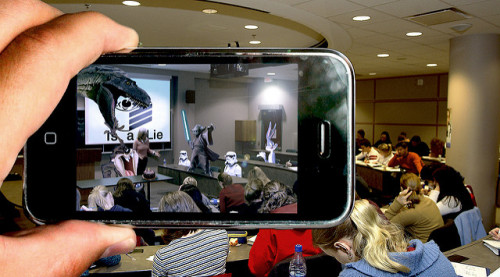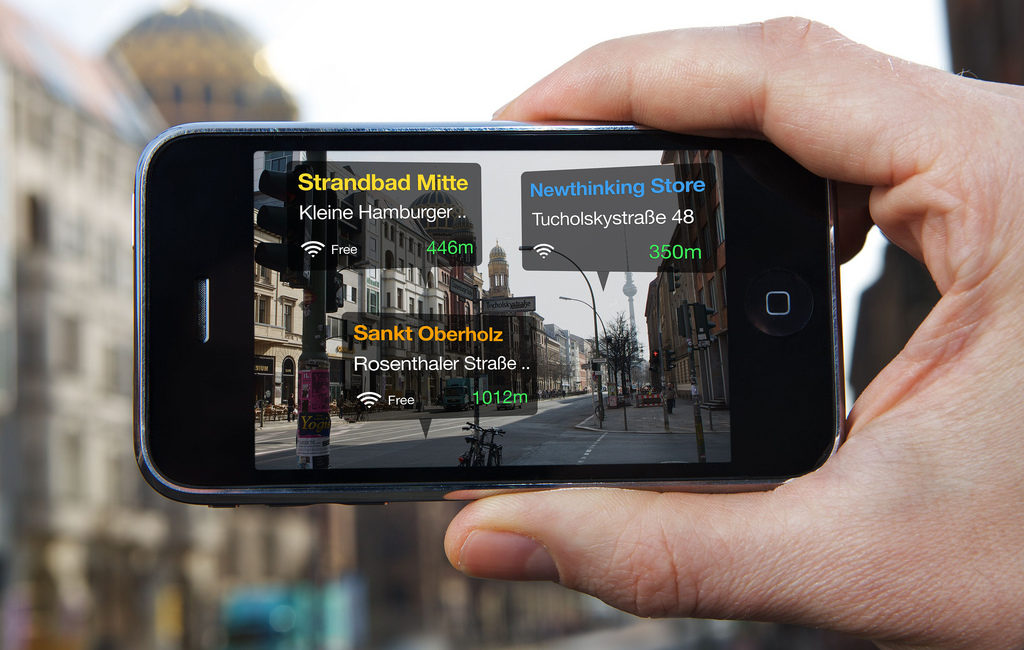Pardon the spatial-rhetorics wordplay here, but I am increasingly getting the sense that the topic at the center of this locative media research group—augmented reality—feels simultaneously like unfamiliar and familiar territory.
I have spent a substantial amount of time researching and reflecting on locative media, especially thanks to my time in Dr. Casey Boyle’s Fall 2014 course “Spatial Rhetorics and Locative Media.” There we’d often discuss the ways in which mobile technologies affect perceptions of embodiment and place, and, as might be expected, smartphones played a major part in these discussions.
How does “augmented reality” fit into this discussion, then? How does it differ from what appears to be this broader category called “locative media”? A useful starting point might be the definition that The Atlantic’s Ava Kofman describes in her article “Dueling Realities”: ” ‘augmented-reality’ describes any technology that overlays digital interfaces onto the physical world. Unlike virtual reality, which immerses you in a simulation using stereoscopic 3D on a screen in front of your eyes, augmented-reality technologies embed opaque holograms directly into the environment.”
Now, let’s look to Dr. Alan B. Craig’s definition from his book Understanding Augmented Reality: Concepts and Applications (2013), who says that augmented reality creates an interactive experience “in which the digital world and the physical world can be merged. The first mode [for merging] is to gather information from the physical world, generate the digital information in the computer, and meld those two worlds together in a computer to be displayed. The other mode is to simply project the augmentations onto the physical world by means of projection devices” (17).

How different are these definitions? Not very and also quite a bit. Both Kofman and Craig loosely define augmented reality in terms of its ability to layer the digital onto the non-digital, but beyond this point there are fundamental differences. For instance, Craig argues that “augmented reality isn’t a technology per se, but rather a medium that utilizes numerous other technologies” (23). On the other hand, Kofman defines augmented reality as technology, but she does not make any mention of which types of technology can do this digital layering.
These two perspectives point to what I suspect is a general perspectival difference between those whose work engages closely with augmented reality and those who encounter it in more casual ways. Craig, who has also written two books on virtual reality and who has spent decades researching these topics, can easily be viewed as an authority in this conversation. However, many of us likely feel confused if not anxious about what augmented reality is and how it can impact our lives. As augmented reality continues to develop, “at stake is the chance to replace the smartphone, the desktop—even the desk,” says Kofman—a bold claim, certainly, but the public’s general lack of knowledge in this area means that is a difficult claim to challenge.
While my own research has a vested interest in augmented reality, this interest is grounded in rhetoric rather than computer studies. This places me somewhere in the middle of Craig and Kofman. Yes, I am interested in examining the spatial and temporal aspects of augmented reality that Craig says are defining features of it (20); no, I am not particularly interested in doing so in order to choose a side about what is and is not augmented reality. This is because I am less interested in general in determining absolutely what something is than I am in exploring what it does.
In terms of augmented reality, I happily intend to include the smartphone in this exploration. Regardless of whether or not the smartphone is an example of augmented reality, and regardless of whether or not augmented reality is a threat to the smartphone, the fact remains that the smartphone tends to be the closest experience that the general public has with the features that are generally attributed to augmented reality. The days in which the smartphone and the desk become obsolete seem quite far off, and I welcome the chance to explore them and everything in between.






